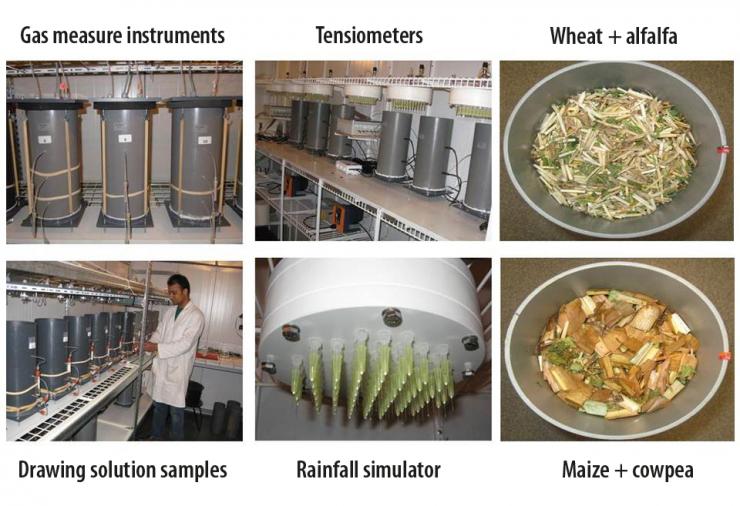Agroecology Reading time 3 min
New findings on mulch decomposition
Published on 12 November 2013

Soil cover is one of the three key components of conservation agriculture. Soil cover can be either live, intermediate crops, or mulches composed of crop residues remaining after previous harvests that accumulate on the soil surface. Retaining mulch between crops provides better protection against erosion and can also maintain higher soil humidity in dry regions, enrich the soil with organic matter, and, if the mulch is sufficiently dense, prevent the regrowth of weeds.
Indicators for mulch efficiency
Mulches are broken down by soil microorganisms. The decomposition process is crucial as it determines the capacity of mulch to fulfil its functions in key areas like coverage rate, the rate of mulch decomposition in the soil, the amount of nitrogen and organic carbon supplied to the soil, and the adsorption and breakdown of pesticides. Researchers from a number of INRA teams have developed a model able to calculate these key variables for various plants and in a number of different soil and climate conditions. “As most soil simulation models do not take mulch into account, we adapted an existing model (PASTIS) to arrive at these new findings” says Patricia Garnier.
Water-retention capacity: a key factor for mulch
If you want to control erosion, you prefer longer-lasting mulch.
“We demonstrated that mulch water-retention capacity is the key factor determining its rate of decomposition. Mulch breaks down more quickly if it traps and stores rainwater. For example, mulch consisting of a mix of maize and cowpea retains humidity better than a mix of wheat and alfalfa and will thus be broken down more quickly by microorganisms.”
This new finding is a new insight into mulch. Until now, decomposition rates were thought to depend on plant biochemical properties, as is indeed the case when plant residues are turned in with tillage. When plant matter remains on the surface, physical properties, like water retention, are more important than biochemical ones. Through the PEPITES project, researchers demonstrated that to measure a plant’s water-retention, all that is necessary is to measure its density (mass/volume).
These findings will allow for more informed choices when selecting plant species to meet a variety of objectives. If the aim is to protect against erosion, then longer-lasting mulch with a slow rate of decomposition is better. The opposite will be true if the aim is to rapidly add mineral nitrogen to the soil for the subsequent crop.
Rainfall: another key factor
Mulch is able to intercept and breakdown pesticides.
Rainfall is another key factor in mulch decomposition rates. In France, mulch often remains damp due to frequent rainfall, accelerating its decomposition. In tropical regions where rainfall is heavy but interspersed with periods of high evaporation, mulch remains dry and decomposition is slower. When exposed to continuous rainfall, mulch can decompose as quickly on the soil surface as it would if it was turned with tillage.
Mulch is able to intercept and breakdown pesticides. In tropical conditions, there is a higher likelihood of pesticides leaching from the mulch to the soil, which may accelerate the flow of pesticides to the water table. There is also a significant risk of pesticide leaching in dry conditions or with clay soil where cracks in the soil might develop.
Choosing cover plants
The model can determine the most appropriate cover crops for given soil and climate conditions. It can be used for a wide variety of temperate crops, including wheat, maize, peas, alfalfa, and soybeans, but also for tropical crops like hyacinth bean (Dolichos lablab), Stylosanthes, rice, Cajanus, and Brachiaria. “We can also virtually test plant combinations whose effects on mulch cannot be predicted simply by adding together the properties of the individual species” says Garnier.
References
- Iqbal A., Beaugrand J., Garnier P. Recous S. 2013. Tissue density determines the water storage characteristics of crop residues. Plant and Soil, 367 : 285-299.
- Aslam S., Garnier P., Rumpel C., Parent S E., Benoit P. 2013. Adsorption and desorption behavior of selected pesticides as influenced by decomposition of maize mulch. Chemosphere, 91 : 1447-1455.
- Aslam S. 2013. Modeling the impact of decomposing mulch on pesticide dynamics in conservation agriculture. Thèse de doctorat Ecole Doctorale Abies. 187 pages.
- Iqbal A. 2013. Effet de la nature et décomposition des mulch de résidus végétaux sur les services assurés par les sols en agriculture de conservation. Thèse de doctorat Université de Reims. 225 pages.
